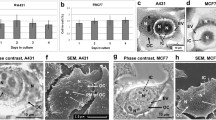Abstract
We studied the effects of dopamine added to culture medium on survival of floating or adherent BHK-21 cells differing by organization of actin cytoskeleton. The viability of floating cells more drastically decreased with increasing dopamine concentration and duration of exposure than that of adherent cells. The cells worse adhered to the substrate and formed a monolayer. The formed monolayer degrades, cell borders become blurred, cells, polygonal in the control, are rounded. Preliminary blockade of dopamine receptors with haloperidol, inessential for cell survival and morphology, does not prevent the destructive effect of dopamine on the cells. Ultrastructural study revealed increased density of filamentous actin threads in deep compartments of cell cytoplasm after dopamine treatment, this increase being more pronounced in cells grown in suspension. Bearing in mind the polymerizing effect of dopamine on globular actin in vitro and the fact that the content of this protein in floating cells is higher than in adherent cells, we can conclude that the decrease in viability of BHK-21 cells is caused by interaction of dopamine with cytoplasmic globular actin.
Similar content being viewed by others
References
E. N. Bezgina, L. L. Pavlik, G. Z. Mikhailova, et al., Neirofiziologiya, 38, No. 4, 320–330 (2006).
E. A. Kosenko, E. I. Lezhnev, I. I. Popova, et al., Kletoch. Kul’tury. Information Bulletin [in Russian], No. 24, P. 3–15 (2009).
D. A. Moshkov, Neuron Adaptation and Ultrastructure [in Russian], Moscow (1985).
L. L. Pavlik, E. S. Bezgina, N. R. Tiras, et al., Morfologiya, 125, No. 2, 26–31 (2004).
L. L. Pavlik, P. A. Grigoryev, V. S. Shubina, et al., Biofizika, 53, No. 1, 66–72 (2008).
V. S. Shubina, M. B. Abramova, V. P. Lavrovskaya, et al., Tsitologiya, 51, No. 12, 996–1004 (2009).
V. S. Shubina, A. D. Sofin, V. P. Lavrovskaya, et al., Retseptsiya i Vnutrikletoch. Signaliz., 1, 401–406 (2009).
R. S. Cantor, Biochemistry, 42, No. 41, 11,891–11,897 (2003).
F. Lázaro-Diéguez, C. Aguado, E. Mato, et al., J. Cell Sci., 121, Pt. 9, 1415–1425 (2008).
P. S. Milutinovic, L. Yang, R. S. Cantor, et al., Anesth. Analg., 105, No. 2, 386–392 (2007).
R. Pedrosa and P. Soares-da-Siva, Br. J. Pharmacol., 137, No. 8, 1305–1313 (2002).
Y. Ujihara, H. Miyazaki, and S. Wada, J. Physiol. Sci., 58, No. 7, 499–506 (2008).
M. L. Vitale and M. E. Carbajal, J. Histochem. Cytochem., 52, No. 4, 517–527 (2004).
Author information
Authors and Affiliations
Corresponding author
Rights and permissions
About this article
Cite this article
Moshkov, D.A., Abramova, M.B., Shubina, V.S. et al. Effect of Dopamine on Viability of BHK-21 Cells. Bull Exp Biol Med 149, 359–363 (2010). https://doi.org/10.1007/s10517-010-0946-8
Received:
Published:
Issue Date:
DOI: https://doi.org/10.1007/s10517-010-0946-8




